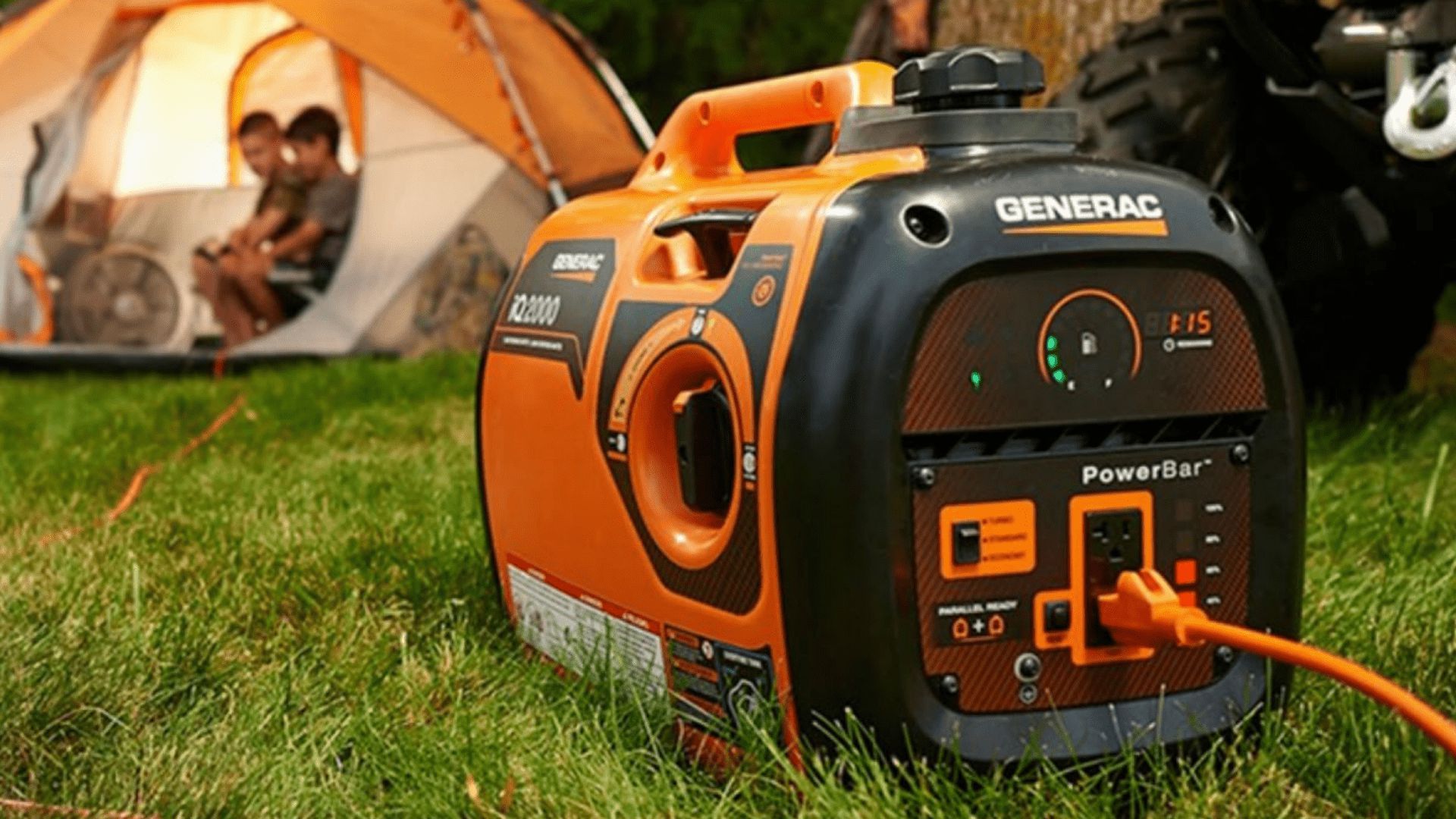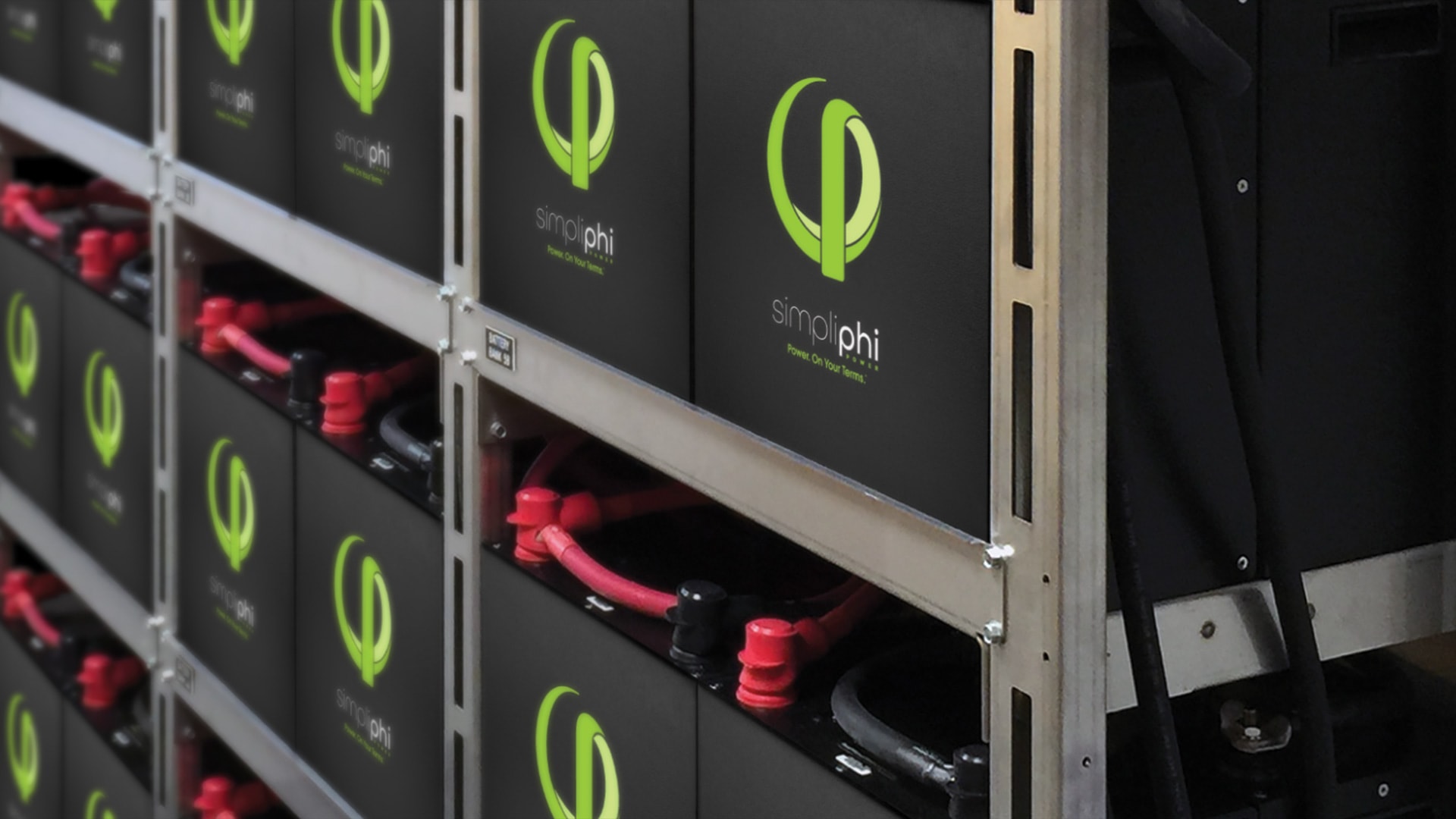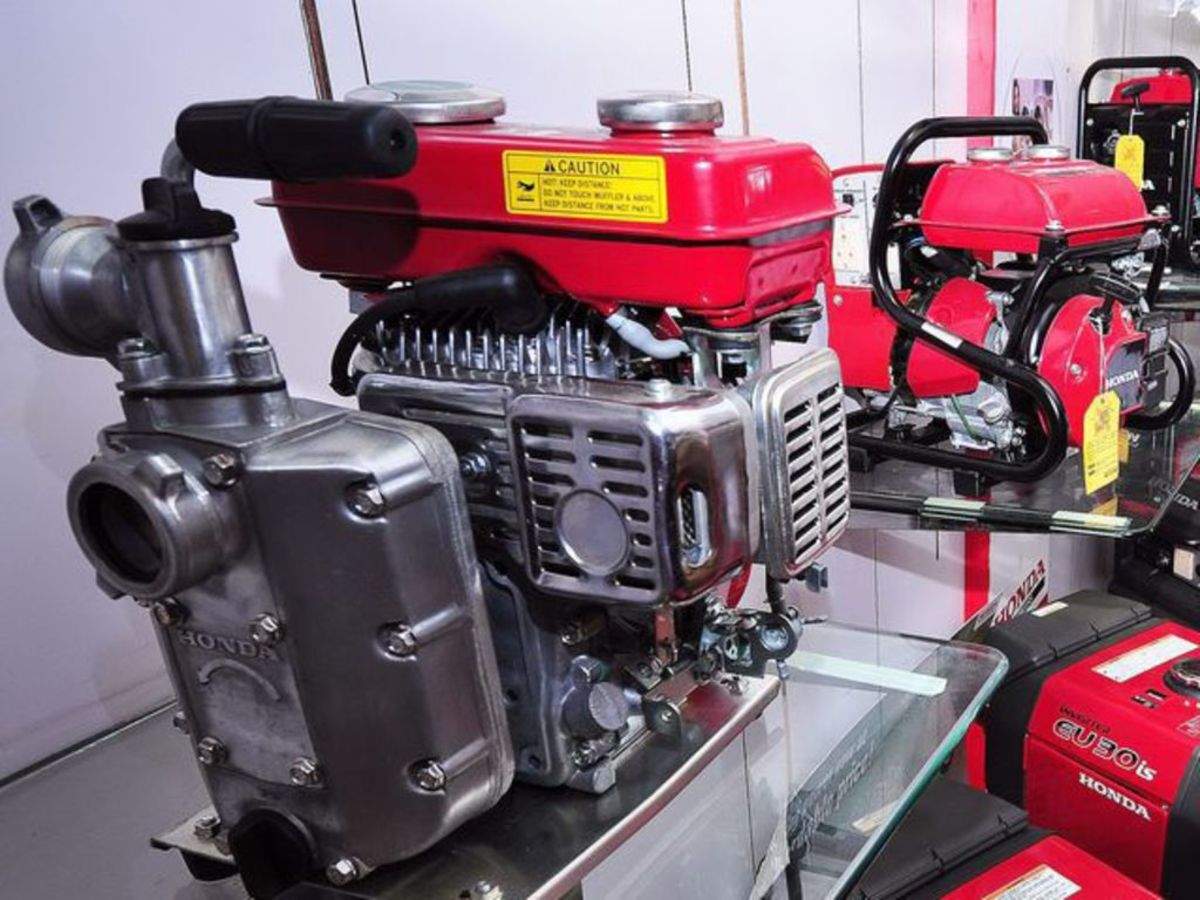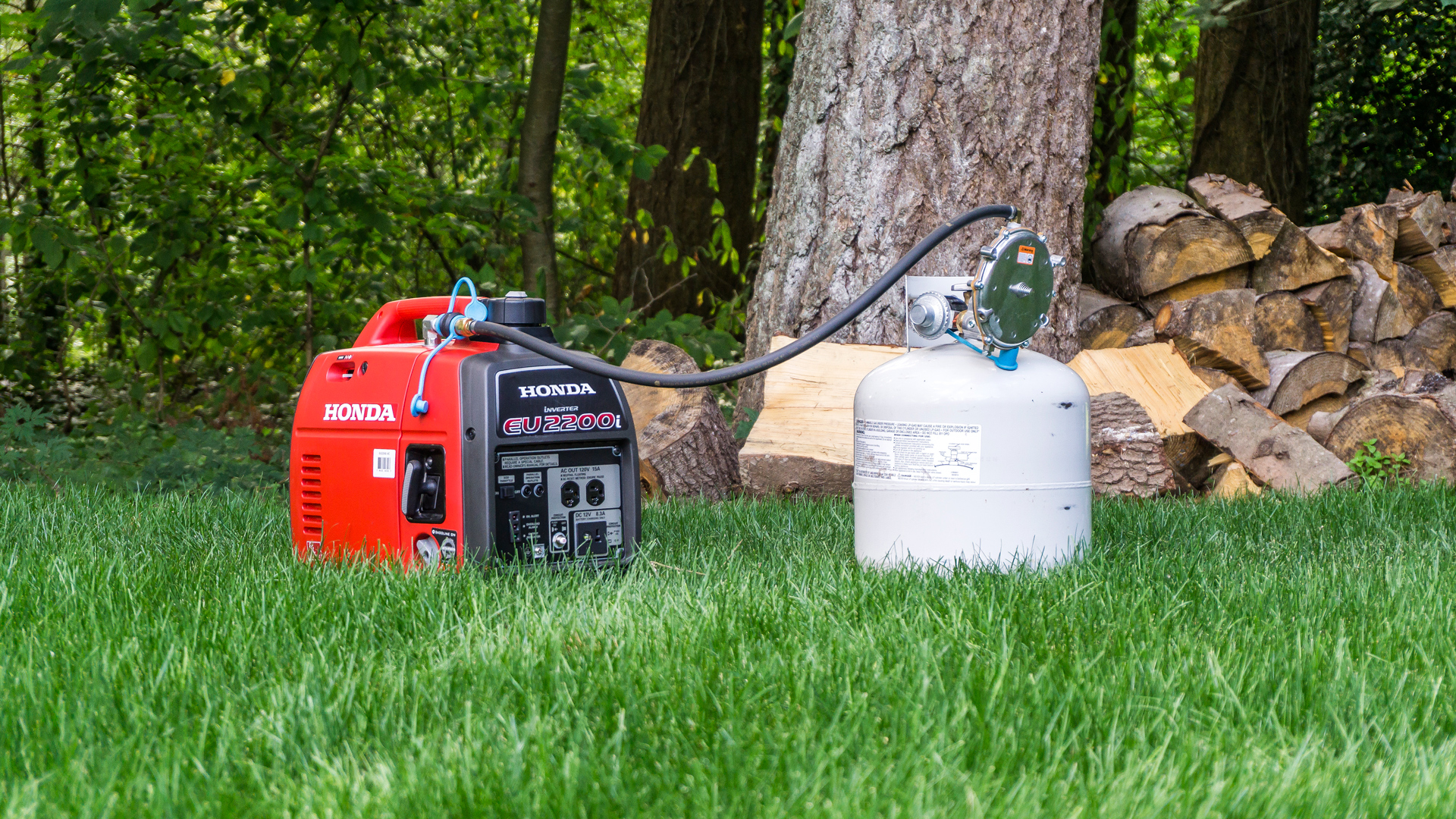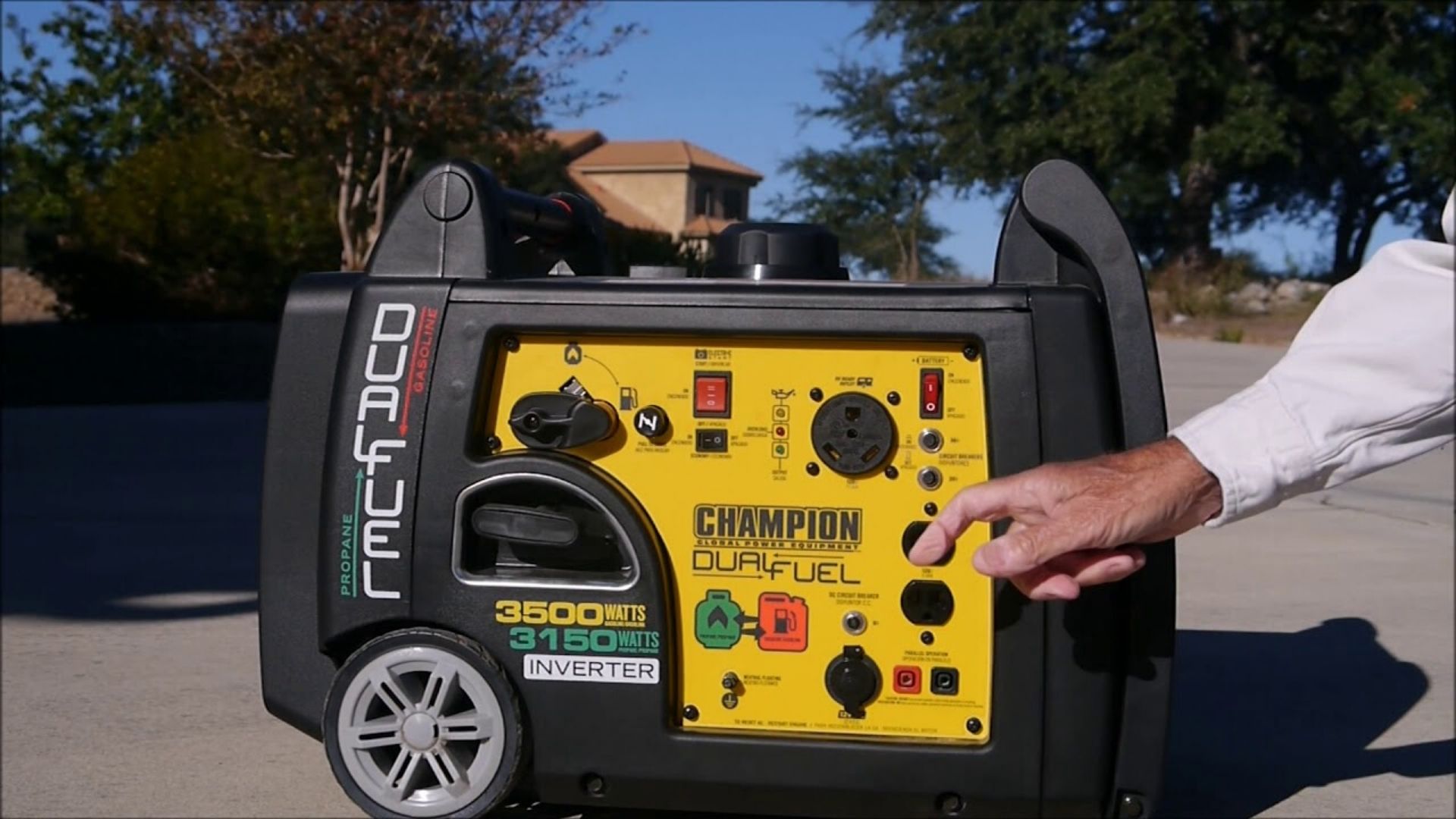A portable generator is a convenient way to take power with you wherever you go, or as a backup power source in your home in case of a power outage. The impact of a power outage of only a few days on our modern lives can become much more serious than a mere inconvenience.
Many companies make hybrid generators that allow you to choose the fuel type that’s best for your situation. There are really two choices. First is the dual fuel portable generator, which comes in combinations of gasoline and propane or natural gas and propane. The second is the tri fuel portable generator, which combines gasoline, propane, and natural gas.
Being prepared means planning ahead so you have options when the time comes you’ve run out of time to plan. Relying on gasoline alone to supply your electrical power needs can be not only inconvenient, but also limit your options in a power outage. For example, gasoline becomes stale if it’s not treated with a stabilizing additive after only one month. So, while gasoline is definitely the most popular choice for portable generators, gasoline has issues as they say. Nowadays, you don’t have to rely on gasoline-only generators.
In our dual fuel generator and tri fuel generator reviews, we’ll cover some of the best models of these multi-fuel generators to help you decide which is the right one for you.
Let’s get to it.
No time to read all the reviews? Click here to go to Amazon to see these generators for yourself.
Click the table below for answers to your pressing questions or to see a particular generator review. Or read on for my Uncut Reviews.
How Does a Dual Fuel and Tri Fuel Generator Work?
The engines used for portable generators are basically the same as are used on lawn mowers, snow blowers, rototillers and pressure washers. Unlike your lawn mower, however, a dual fuel generator or tri fuel generator is built to run on more than one type of fuel. This is why they’re so flexible and so useful. This can be especially true in longer emergencies when gasoline may become hard (even impossible) to find.
Are Dual Fuel and Tri Fuel Generators Reliable?
The reliability of a multi-fuel generator depends on at least a couple of factors, such as how often the generator will be operated (or at least tested) and the type of fuel used. These factors tend to be related to one another—especially if gasoline is your preferred fuel source. Remember, gasoline deteriorates if it sits for longer than a month or so. So unless you’re diligent about using a fuel stabilizer additive or following a schedule to rotate your older stores of gasoline, you may find yourself with “stale” gas that your generator engine not run on or will run but inefficiently. Stale gasoline is also hard on the engine and, over time, will cause it to operate less reliably.
On the other hand, propane (also known as liquid propane, LP gas, and LPG) and natural gas (NG) are quite stable. Propane can be stored for much longer than gasoline without worrying about it degrading—for several years, in fact. Be sure to store LP tanks (also referred to as cylinders) away from moisture and out of the elements. This is to keep the tank valves from rusting which will create connection problems, not anything to do with maintaining the quality of the LP itself. The National Fire Protection Association publishes useful information on the safe storage and handling of gasoline and propane.
Natural gas is most commonly used with whole house standby generators that connect directly to a home’s gas line. However, it is becoming a more popular choice in smaller portable storage applications using tanks similar to how propane is stored. And, like propane, natural gas can be stored almost indefinitely.
These storage tanks can be purchased in a variety of sizes. They range from small 5-gallon, 20-pound size commonly used on your backyard grill to 100-pound cylinder tanks to the very large, pad mounted tanks with 500 gallon to 1,000 gallon capacities which provide for all of a home’s fuel needs.
It’s important to properly maintain your generator regardless of which fuel type used. Run your generator at least once each month if you can, and definitely no less often than once every two months. Let the engine run long enough to fully warm up and heat up the fluids. This ensures the generator engine’s moving parts are well lubricated and the fuel in the lines is burned through the carburetor.
What are Some Uses for a Dual Fuel and Tri Fuel Generator?
Image Source
Multi-fuel portable generators are very flexible and have several valuable uses. They work very well for camping and in an RV. They’re also very popular with contractors at construction sites or other commercial uses where small tools and other equipment requires electrical power be brought to the job site. Gasoline is far and away the most popular fuel for both of these uses, but being able to use a second fuel—especially propane, is convenient.
These types of generators also work well as a backup power source at a home to run the lights and a few appliances in an emergency power outage. It’s this use where the flexibility of a multi fuel generator really shines.
Do Dual Fuel and Tri Fuel Generators Come with an Electric or Remote Starter?
Yes, most generator manufacturers do offer models with electric and remote starters. In fact, it’s an important features to consider. This one option will simplify your life when the power goes out in the middle of the night, in the dark with only a flashlight (hopefully) and you need to get the power on fast. Simply turn the key (or push a start button) and its internal battery turns over the engine. All electric start generators also have a pull start as a failsafe backup in case the battery dies or there’s another problem with the electric starter.
There are a number of generators with this feature, but I especially like the tri fueled Powerland PD3G10000E, which has an electric starter. I also like the Smarter Tools ST-GP7500DEB, which is a smaller dual fuel (gas and propane) model. I review both of these generators below.
What Does the Government Say About Using Generators?
The potential seriousness of being without electrical power at home is significant—even potentially life threatening. The U.S. Department of Energy has guidelines on how people can protect themselves from power outages. Also, if you or a family member depends on electrical power for a medical reason, the Federal Emergency Management Agency may reimburse you if you buy a generator under a special program. For those medically dependent on electrical power, the Frank D. Lanterman Regional Center of Southern California has published a helpful disaster preparedness guide, “Emergency Power Planning for People who use Electricity and Battery Dependent Assistive Technology and Medical Devices.”
What Size Generator Do I Need?
Most people find they can run their most important home appliances and devices with 3,000 to 6,500 watts. If you have a smaller home with a smaller furnace or air conditioner, you’ll be on the lower end of this range, and if you have a larger furnace or run your central air conditioner frequently, you’ll be on the upper end. Similarly, if you need to run a pump to get water from a well, your power needs will be higher. This range is based on average loads and uses. We’ve created a handy cheat sheet you can use to estimate more precisely the size generator you’ll want to buy for your situation.
Dual Fuel Portable Generator Reviews: Propane and Gasoline Generators
DuroMax Generators
The DuroMax line of products is a well-regarded manufacturer of electrical generators. The XP4400EH model can be counted on to put out 4,400 starting watts and 3,500 running watts consistently. With its 4-gallon fuel tank, on gasoline you can expect to run it for about 8 hours at half-load.
At only 128 pounds, this portable generator really is portable. It’s easy to move anywhere you need it to plug into. The steel frame, wheels and built-in handles make it convenient to move and operate.
It comes with an electric start, so it’s easy for anyone to get it running—and, of course, it has a pull start too in case the battery dies. It also features a low-oil protection system, which will shut off the engine should it run low on oil due to a leak or if you just forget to check the oil level (don’t do this).
I generally like the Duromax power panels, they’re easy to read and understand. For example, they come with an easy-to-read analog voltmeter (I find them easier to read, in any case), two 120V outlets, and one 30-amp 220V twist lock outlet.
What’s so great about having all these outlets? It gives you options, and when you need backup power you can never have too many outlets where flexibility counts for a lot. This model would work great with an RV or camping. Its small size makes it fairly easy to handle. It’s also a good option at the job site if you’re a contractor and you need portable power to operate your tools.
Now, at 3,500 running watts, this dual fuel portable generator is definitely on the lower end of the power range of the models on our list. But as a backup at home, it should work fine to power the minimum “necessary” home appliances and devices in the typical home. But I don’t recommend wiring this model into your home’s electrical system, however. It’s just not powerful enough to justify using it this way. Go with a more powerful model if this is what you intend to do.
A big plus is that, at 69 dB, it is quieter than most portable generators—at least quiet enough that you could have a conversation several feet away from it. This is another reason it’s a good choice at the campground and in the recreational vehicle. Generator noise level can be a significant consideration, depending on the intended use, siting options, and personal tolerance for loud noises. To help you gauge the noise levels of the different models, we’ve provided you with a noise level comparison chart.
The XP10000EH is the bigger brother of the XP4400EH. It’s for those who need more power. It puts out 10,000 starting watts and 8,000 running watts, so it’s suitable for a much larger range of uses.
You get the same easy to use DuroMax power panel, of course. And like its little brother, this model comes with an impressive array of outlet options, including two 3-prong 20 amp 120V outlets, one 30 amp 120V (with twist lock) outlet, one 120V/240V 30 amp (with twist lock) outlet, one 50 amp 120V/240V heavy duty outlet, and one 10 amp 12V outlet.
That’s a lot of receptacle options! These last two outlets are really nice if you want to run an energy hog appliance or have to operate heavy duty, high voltage power tools on the job.
Whatever your power needs, this tough generator can get it done. It even features a 12V outlet for charging car batteries. And all these outlets are fully protected by circuit protectors and a circuit breaker.
With more power, however, comes more engine noise. While it’s advertised as “super quiet,” I’d advise you not to try to carry on a long conversation while standing next to this model. Its 72dB rating is from 22 feet away, and so any closer and it’s going to be quite loud.
The XP10000EH is primarily intended for heavy duty uses. So if you need something to power your entire house, including heating or air conditioning and a sump pump, for example, or you need to power high voltage power tools at the job site, then the DuroMax XP10000EH will get the job done very nicely.
Click Here for Great Pricing on Amazon for the DuroMax XP10000EH
Champion Power Equipment Generators
Champion Power Equipment is also a well-established brand in the generator industry. This popular model is relatively lightweight at 119-pounds, a little lighter than the DuroMax XP4400EH, so it should be easy for most anyone to move.
With a 3.4-gallon gas tank, you should get around 8 hours on a full tank running a half-load. I wish it had a little larger capacity, though, as I think getting a full 8 hours out of it might be a bit of a challenge. Or if you choose to run it on propane, expect around 5 ½ hours on a backyard grill-sized 5-gallon, 20-pound propane tank.
With 3,800 running watts and 4,750 starting watts on gasoline (3,420 running watts and 4,275 starting watts on propane), there’s enough power to operate the necessities in your home, though not all at the same time.
This model is also a great choice if you’re looking for a portable dual fuel generator to take on the road with you. You’ll love the built-in TT30 RV receptacle for your RV. It also has a good selection of other outlets, including one 120V duplex outlet (5-20R), and one 120V twist lock style outlet (L5-30R).
I really like the Champion power panel in terms of functional layout and readability quite a bit. It has overload protection, a low oil sensor and something called an “Intelligauge” which displays volts, hertz and operating time information.
Champion equipped the Model 76533 with a few handy extra features. It has an electric start (battery included) and backup pull start system if you need it. The Champion Model 76533 is EPA certified and CARB (California Air Resources Board) compliant, so it can be operated in all 50 states. It also comes with a 2-year limited warranty.
As far as portable generators go, it’s awfully hard to beat the feature rich and user-friendly line up of Champion generators. For a dual fuel generator, they get top marks. I highly recommend the Model 76533 if its power output rating matches your power needs.
Click Here for Great Pricing on Amazon for the Champion Power Equipment Model 76533
The Champion 100165 is the big brother of the previous model. It comes with all the same basic functionality, just with more power. It delivers 9,375 starting watts and 7,500 running watts on gasoline (8,400 starting watts and 6,750 running watts on propane). With this power rating, you could expect to run the lights, TV, refrigerator, sump pump or well pump, furnace fan, security systems and a window air conditioner, all at the same time, and on either fuel.
Under a half-load, the 6-gallon fuel tank will give you about 8 hours of operation on gasoline, and a 5-gallon propane tank (not provided) will run for around 5 ½ hours.
This model’s power panel has two 120V Duplex GFCI outlets (5-20R), one 120V/240V twist lock style receptacle (L14-30R), and one 120V twist lock style receptacle (L5-30R). Its electric start makes it super-easy to operate, and it comes with all the circuit protectors and a circuit breaker to protect your appliances, devices and power tools.
This Champion model is EPA certified and CARB compliant as well, so it can be operated in any state. And, of course, it comes with the same 2-year limited warranty as its little brother.
I recommend this model for all the same reasons I recommend its smaller brother. If you need the extra power at home, or even if you’re looking to easily power several high voltage power tools at the same time on the job site, the Champion Model 100165 is tough to beat. Period.
Click Here for Great Pricing on Amazon for the Champion Power Equipment Model 100165
BONUS: Other Good Choices
Pulsar portable generators have a much more polished look to them than the other model on our list, which tend to be more utilitarian in looks. Don’t be fooled, though, the Pulsar has more to offer than a sleek design that doesn’t compromise great performance.
With a 13 HP engine, the PG7500B generates 7,500 starting watts and 6,000 running watts on gasoline. This puts it in the middle of the power output range of the other models in this list. Pulsar does sell two other models, so if you like this generator but want a more power or less power, there’s the Pulsar PG10000B, rated at 10,000 starting watts and 8,000 running watts, and the Pulsar PG4500B, rated at 4,500 starting watts and 3,500 running watts. So you should be able to find one that meets your needs.
The Model PG7500B also has an electric push start (with the requisite recoil pull start as a backup) for easy operation. And it comes with a digital volt meter on its control panel and features four 120V outlets and two twist lock outlets: a 120V and a 120V/240V. This makes it great for use as a home backup generator or with your RV.
One thing I really like about this model is that you can operate it a little longer than the other models on our list. On a half load, you should get up to 13 hours of run time on gasoline. But it’s just as loud as most of the other models, though, ringing in at around 74dB.
This is just a good looking, very functional generator—and the fact it will run 13 hours on a single tank of gas is a big plus, especially if you’re looking for a portable power source for on the job, day in and day out or you want to take it along on your next RV road trip or campout.
Did I mention it runs for 13 hours on a single tank of gasoline?… Run time matters.
Bottom line, Pulsar is a good option and has a model that will meet your portable power needs.
This Sportsman model is another portable generator in the mid-power range. It creates 6,000 running watts and 7,500 starting watts on gasoline. It also features all the same outlet options of the Pulsar models, as well as having a keyed electric start (I prefer a push button starter so I don’t have to worry about losing the key) and pull start capability.
It doesn’t run quite as long as the Pulsar model, however. On a full 6.2-gallon tank of gasoline, you should expect to get around 9 hours of operation.
This is more than enough for most people, but if you really need that extra time, the Pulsar model might be a better option.
Click Here for Great Pricing on Amazon for the Sportsman GEN7500DF
Another generator in this power range worth a closer look is the Smarter Tools ST-GP7500DEB.
It offers the same power output as the Sportsman (7,500 starting watts), has slightly more running watts at 6,200 watts. It also run about 9 hours on its 6.6-gallon gas tank or 7-8 hours on a 5-gallon, 20-pound propane tank. Like the Sportsman it comes with an electric starter, so getting it up and running can be accomplished by anyone.
The Smarter Tools generator is a good choice if you’re in California or just want a generator that’s a little more environmentally friendlier. It’s fully EPA approved and CARB compliant, so can be used in all 50 states.
Click Here for Great Pricing on Amazon for the Smarter Tools ST-GP7500DEB
Dual Fuel Portable Generator Reviews: Propane and Natural Gas Generators
There aren’t nearly as many propane-natural gas (LPG-NG) dual fuel generators made, because gasoline is by far the most popular fuel source for all portable generators. But if you want a portable generator and don’t want to mess around with gasoline, this NorthStar model fits the bill.
A Honda engine powers this open frame generator. It has easy hook-ups to connect to the propane or natural gas lines in your home. On natural gas, it puts out around 8,400 running watts and 10,000 starting/surge watts, and on propane it generates 9,450 running watts and 10,000 starting/surge watts.
Another reason the NorthStar Model 16956 is an especially good choice for backup power for your home is that it puts out “clean” power that will not damage sensitive electronics. This is due to the low THD (total harmonic dissonance) produced by its 100% copper wound brushless head.
Less distortion = cleaner power
When the power does inevitably go out, an impressive array of outlets specially designed for home use is available to plug into, a total of 11 receptacles! Eight of these are 120V outlets. There are also separate twisting lock style outlets to wire directly to your RV or home breaker box.
This is a great option for those who experience outages more often than they care to and need “clean,” reliable electric power for their electronics and the rest of their home. There’s no reason to go without the necessities of modern life if you have this very capable dual fuel generator standing by.
Click Here for Great Pricing at Amazon for the NorthStar Portable Dual Fuel Generator Model 16956
Tri Fuel Generator Reviews
This Yamaha powered generator sold by Smart Generators can operate on three different fuel sources: gasoline, propane or natural gas.
The commercial-grade Yamaha engine delivers 12 HP, which will provide around 6,800 running watts on gasoline or propane. When powered by natural gas, you can expect to get around 5,500 running watts. So no matter if you run it on gasoline, propane or natural gas, this generator will put out enough to keep the critical devices in your house powered a power outage.
The 8-gallon gas tank will run 11-13 hours on a half load, and you can get around 20 hours of run time with 40 pounds of propane. The engine also features a low-oil shut-off so that if the oil gets low you do not have to worry about damaging the engine. This engine protection feature will save your generator if the oil level is too low.
I like this generator and how it’s set up a lot. It’s ideal for someone looking for an all-inclusive set up. It comes with two 10-foot long connection hoses with fittings, one for natural gas and one for propane. The package also includes a wheel kit so you it’s easy to roll it to wherever you want, a battery and charger, and a Drainzit oil change kit. Altogether, these extras would cost about an additional $400.
On top of all the extras in the package, though, this generator will give you the peace of mind to power your sensitive electronics with it. It uses a “twist lock” outlet from an Armour alternator with an “auto voltage regulator” which enables it to put out “clean” power that won’t damage your laptop or television. In technical terms, it produces just 6% THD (total harmonic distortion), which is very good.
On the negative side, it is a little noisy. It operates at around 75dB, which is a little louder than you’ll want to stand next to for very long. So this may be best used away from where people will be congregating.
With free shipping (check Amazon to confirm it’s still being offered), a 2-year limited warranty, and all the accessories you need to hook up to propane and natural gas, this is a great tri fuel generator that’ll keep the lights on and let your family use their electronics without worry.
Click Here for Great Pricing at Amazon For the Yamaha Tri Fuel Generator Complete Package
This tri fuel generator offers all the features you expect from Powerland. It comes with a 16 HP engine that delivers around 10,000 starting watts and 8,000 running watts. It has dual cooling fans to keep the unit from overheating and a low-oil shutoff to protect the engine.
You can easily switch between 120V and 240V with the twist of a knob, making voltage selection super easy. It comes with a voltage meter on its control panel so that you can easily monitor the power output. It also has a heavy duty circuit breaker to ensure a power surge doesn’t damage your equipment and circuit protectors that operate on each outlet.
And here’s a nice extra: The 12V DC (direct current) outlet makes it easy to use this generator to charge standard automotive batteries, so it can do double duty if in the morning to begin your work commute you find your car battery has died.
Powerland has also equipped this unit with an electric starter as well as a heavy-duty muffler to help quiet the engine. It’s still fairly loud so you’ll want to keep it some distance from where people are.
This Powerland model also features a 16 HP engine, but with slightly less power output than its bigger cousin, the PD3G1000E model. It’s a little more expensive, however, because it’s EPA certified for all 50 states and also meets the more stringent CARB requirements of California too.
If you live in California, or you want a generator that will operate on traditional fuels but still want a reasonably environmentally friendly, then this is a good choice.
Running on gasoline, it delivers 8,500 starting watts and 7,000 running watts, still plenty to keep the average-sized home’s basic electrical needs functioning.
Like the other models on the list, it will run around 72 to 75 decibels, so it’s not considered a quiet generator but that’s about what you can expect generators capable of producing this range of power output.
This model also features an electric starter for convenient operation, with a pull start backup should the electric starter fail for some reason.
This is a great model for those wanting a backup for home use, or for contractors who need reliable, portable energy.
Click Here for Great Pricing at Amazon for the Powerland Portable PD3G8500E
The Verdict
Whether you want the flexibility, safety or convenience that a portable dual fuel or tri fuel generator offers, any of these models will keep your lights on, your appliances running, or your power tools running for many hours. With a little planning and preparation on your part, you’ll never have to worry about running out of gasoline to operate your generator with these multi fuel options.
Dual Fuel Recommendation
Here, I like any of the Champion Power Equipment models the best. Just figure out the power output you need to know which model is the right one — you can’t go wrong with any of them.
Tri Fuel Recommendation
If funds aren’t a limiting factor, the Yamaha Complete Package is hands down the way to go for a tri fuel generator. However, the less expensive Powerland line up is a less expensive but still good option. The PD3G10000E offers more power than the portable model, the PD3G8500E, but if you’re in California or you just want a more environmentally friendly option, the 8500 model is the way to go.
I hope these reviews answer your questions and will help you to choose the best fuel type for your generator for your situation. Here’s that checklist tool again to help you estimate the power output you need.


